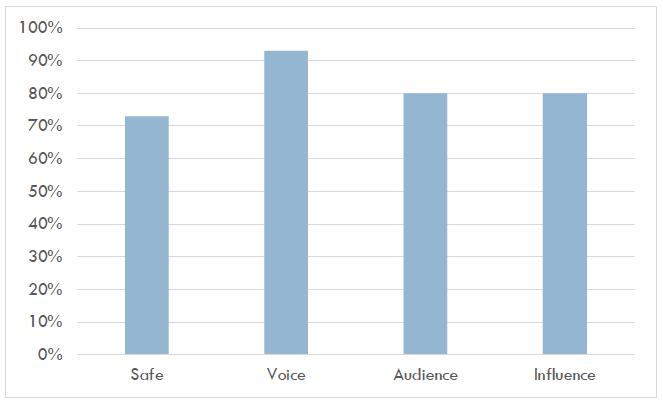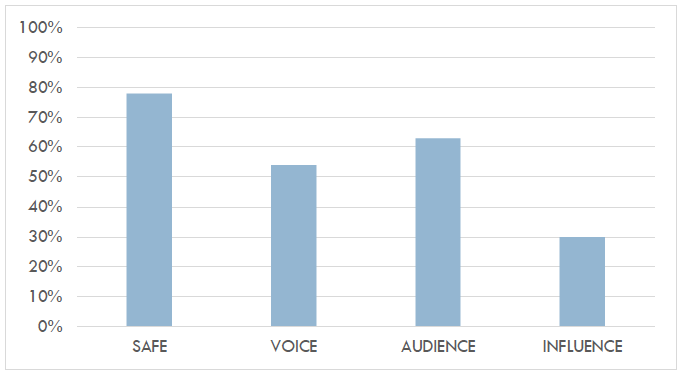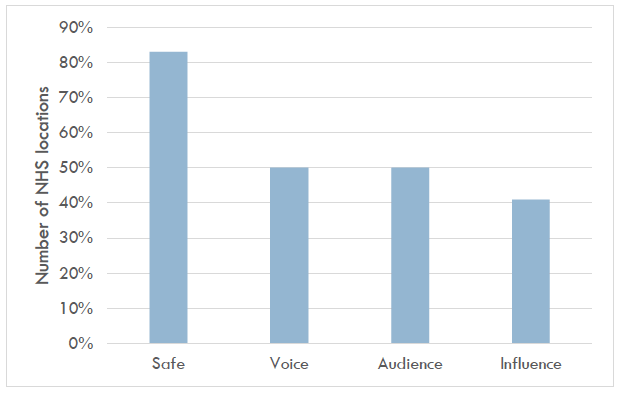Can Scotland be Brave – Incorporating UNCRC Article 12 in practice
This project investigated how well practitioners, understood and implemented the full obligations of Article 12 of the United Nations Convention on the Rights of the Child (‘UNCRC’).
Results
In total, 56 CYP practitioners completed TM training:
- 16 staff from Indigo group -early years setting, out of school care (primary age) and Indie youth group (secondary age)
- 20 staff at Langlees Primary (preschool to primary teachers and learning support staff)
- 20 Occupational Therapists from NHS Fife – (including assistants and those with responsibility for Looked after Children)
A total of 90 case examples were received.
The age of the CYP ranged from 2 years to 16 years.
Pre-training Baseline Measure
This section contains the pre-evaluation data from all three services.
Lundy's checklist and the pre-training questionnaire provided a baseline measure for measuring the impact of Talking Mat training and an evaluation of Child-Rights Based Decision Making within each service. (Appendix 1) The checklist and questionnaire were completed prior to receiving Talking Mats training. The results were used to help each service to identify areas that required improvement.
Third sector childcare service

Figure 3 Description
Staff from Indigo rated themselves on the Laura Lundy model of participation
73% said they provide a safe space for children and young people to express themselves freely and their views are actively sought
93% said they give the children and young people in their service a voice and capture their views in a range of different ways
80% said they give their view an audience and share with relevant others
80% said the views of children and young people have a direct influence on the final decision and feedback is given explaining the reason for the decision.
Staff representing early years, primary and secondary provisions working in 5 different locations completed the questionnaire. Figure 3 above shows practitioners self-rating to each element of the Lundy Model.
The majority of practitioners indicated that there is a safe space where CYP can express themselves freely They work to build relationships with CYP who are shy, or have difficulty expressing themselves. However, access issues and a lack of space were highlighted as barriers faced by staff in some locations. In addition, practitioners highlighted that improvements were needed to actively seek CYP views.
Child participation has been a key focus within the service and the principle of capturing and recording a CYP's voice is well established. Practitioners indicated that CYP were aware they do not have to give their views if they don't want to. Feedback is often, but not always, given, explaining the reasons for decisions taken to those who give their views. This was identified as an area to improve. There are processes in place where CYP views are shared with relevant others, including through social media and providing feedback to parents. Discussions are recorded and considered by those with the power to affect change; however, this was identified as problematic when involving outside agencies.
Practitioners also demonstrated that CYP could express their views in a variety of creative ways. For example, visual aid boards, and allowing feedback to be provided by peer representative groups. However, they were not always confident that CYP knew to whom their views were being communicated.
Overall, the pre-evaluation suggests that although the childcare service rated itself as adhering well to the obligations of Article 12: having a suitable safe space; being proactive in seeking views; giving accessible feedback explaining the reason for a decision and working with outside agencies were all identified as areas for improvement.
Primary School:

Figure 4 Description
Staff from Langlees primary rated themselves on the Laura Lundy model of participation.
78% said they provide a safe space for children and young people to express themselves freely and their views are actively sought
54% said they give the children and young people in their service a voice and capture their views in a range of different ways
63% said they give their view an audience and share with relevant others
30% said the views of children and young people have a direct influence on the final decision and feedback is given explaining the reason for the decision.
Figure 4 above shows the proportion of school staff that identified adherence to each element of the Lundy model.
Most practitioners felt that, although there was safe space available in school, they were not always able to access it when required. As a rights respecting school, the views of CYP were actively sought, through: the use of pupil councils; anonymous votes; values promotion group; pupil leadership roles; GIRFEC pupil view sheet and others. A variety of techniques are used to help shy children express themselves, including daily emotion check-ins and circle time.
The 'Voice' element was mostly adhered to by the school, with over 50% of staff stating that CYP are aware that they do not have to give their views and indicating that CYP are provided with enough information to make an informed decision. Visuals were identified as the most common method used.
In terms of the audience and influence elements, all staff said that there were processes in place for sharing CYP views, including Team Around the Child (TAC) meetings, pupil leadership groups, and sharing CYP views with parents through meetings, consultations, parent nights and report cards. Pupil leadership groups are used to encourage CYP views to contribute to change, and ensure pupils are listened to and taken seriously. The majority of staff members also indicated that CYP know to whom their views are being communicated. However, 6/11 staff members identified potential difficulties of sharing views with someone with power to make decisions, and two staff identified difficulties they had communicating with other agencies, such as social work and educational psychologists. TAC meetings were identified as a useful way to share information with other agencies however, 8/11 staff expressed a lack of confidence that CYP views were considered by those with the power to effect change. Most of the staff were unsure about the procedures in place to ensure CYP views are taken seriously, and also indicated that CYP were not usually provided with reasons for decisions taken.
Overall, the pre-evaluation results from the primary school indicate that practitioners are partially adhering to elements of the Model. Things to improve are: providing a safe space where children can express themselves freely; letting children know they don't need to be involved in influencing the outcome of a decision if they don't want to; multiagency working; putting procedures in place to ensure views are taken seriously and providing feedback explaining the reasons for a decision.
Occupational Therapy Service

Figure 5 Descripion
Occupational Therapists rated themselves on the Laura Lundy model of participation
83% said they provide a safe space for children and young people to express themselves freely and their views are actively sought
50% said they give the children and young people in their service a voice and capture their views in a range of different ways
50% said they give their view an audience and share with relevant others
41% said the views of children and young people have a direct influence on the final decision and feedback is given explaining the reason for the decision.
Feedback on the use of Talking Mats
Figure 5 above shows the proportion of OT practitioners that identified adherence to each element of the Lundy model.
Providing a safe space was the element most adhered to by the OTs. However, while all staff indicated that CYP views are sought at assessment, the majority also indicated the problem of reverting back to parents, particularly in situations where children had communication difficulties. Staff highlighted ways in which they make CYP feel more comfortable by building relationships, making the clinic a safe space, using familiar visuals, and adapting wording of questions. However, it was also mentioned that the provision of a safe space for children to express themselves can be dependent on parents, and whether the child feels safe.
All practitioners mentioned that children are unaware that they do not have to take part in a decision if they don't want to. It was highlighted that the presence of parents reinforces this feeling that children must take part. All mentioned the difficulty in sharing views with someone who has the power to make decisions, emphasising the time it can take to get in touch with external agents. All indicated that CYP views are not always considered as highly as they should be, and the majority highlighted that there are no systems in place to ensure CYP views are taken seriously.
The use of visual supports and adapting verbal information was identified as being used to assist CYP decision making. However, some staff indicated that engaging and listening to CYP choices could be improved upon, and concerns were also expressed that CYP may not fully understand the decisions they are making. Overall, there was a reliance on parents for making decisions and parental consent was often sought by practitioners when sharing CYP views instead of asking the child or young person directly. Some practitioners use verbal communication to inform CYP who their views will be shared with, but this tends to be only communicated to older children.
Lastly in relation to the 'Influence' element, consideration of CYP views depends on the child and the situation. Tools such as the Canadian Occupational Performance Measure COPM[25] ensures that both CYP and parent views are recorded and can be communicated to others. The majority of practitioners mentioned that feedback is provided to CYP at the end of sessions. However, it was also mentioned that reports are only fed back to parents and the child is not always included in discussions regarding discharge.
Overall, the pre-evaluation results from the OT service indicate that practitioners are partially adhering to elements of the Model. Things to improve are: being more proactive in seeking the views of CYP; letting children know they don't need to be involved in influencing the outcome of a decision if they don't want to; multiagency working; putting procedures in place to ensure views are taken seriously and providing feedback explaining the reasons for a decision.
The Lundy model helps to break down what is required to fulfil the obligations of Article 12 and UNCRC.
We will now consider how Talking Mats can be used with the Lundy model to give practitioners a practical way of improving, and evidencing, their adherence to the requirements of Article 12.
Contact
Email: Charles.laing@gov.scot
There is a problem
Thanks for your feedback